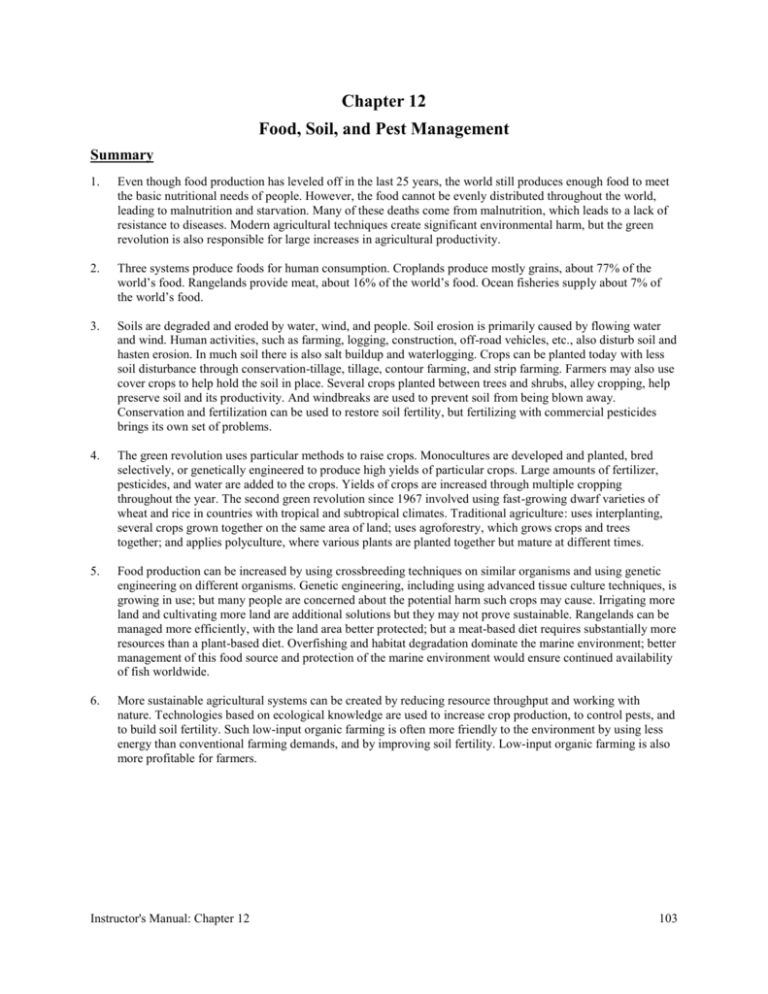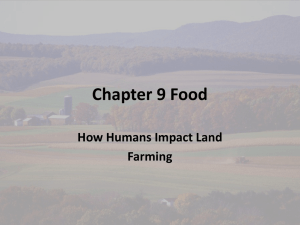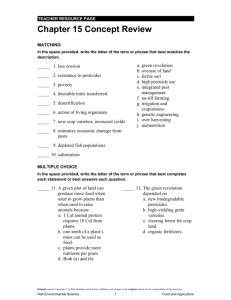Food and soils study guide
advertisement

Chapter 12 Food, Soil, and Pest Management Summary 1. Even though food production has leveled off in the last 25 years, the world still produces enough food to meet the basic nutritional needs of people. However, the food cannot be evenly distributed throughout the world, leading to malnutrition and starvation. Many of these deaths come from malnutrition, which leads to a lack of resistance to diseases. Modern agricultural techniques create significant environmental harm, but the green revolution is also responsible for large increases in agricultural productivity. 2. Three systems produce foods for human consumption. Croplands produce mostly grains, about 77% of the world’s food. Rangelands provide meat, about 16% of the world’s food. Ocean fisheries supply about 7% of the world’s food. 3. Soils are degraded and eroded by water, wind, and people. Soil erosion is primarily caused by flowing water and wind. Human activities, such as farming, logging, construction, off-road vehicles, etc., also disturb soil and hasten erosion. In much soil there is also salt buildup and waterlogging. Crops can be planted today with less soil disturbance through conservation-tillage, tillage, contour farming, and strip farming. Farmers may also use cover crops to help hold the soil in place. Several crops planted between trees and shrubs, alley cropping, help preserve soil and its productivity. And windbreaks are used to prevent soil from being blown away. Conservation and fertilization can be used to restore soil fertility, but fertilizing with commercial pesticides brings its own set of problems. 4. The green revolution uses particular methods to raise crops. Monocultures are developed and planted, bred selectively, or genetically engineered to produce high yields of particular crops. Large amounts of fertilizer, pesticides, and water are added to the crops. Yields of crops are increased through multiple cropping throughout the year. The second green revolution since 1967 involved using fast-growing dwarf varieties of wheat and rice in countries with tropical and subtropical climates. Traditional agriculture: uses interplanting, several crops grown together on the same area of land; uses agroforestry, which grows crops and trees together; and applies polyculture, where various plants are planted together but mature at different times. 5. Food production can be increased by using crossbreeding techniques on similar organisms and using genetic engineering on different organisms. Genetic engineering, including using advanced tissue culture techniques, is growing in use; but many people are concerned about the potential harm such crops may cause. Irrigating more land and cultivating more land are additional solutions but they may not prove sustainable. Rangelands can be managed more efficiently, with the land area better protected; but a meat-based diet requires substantially more resources than a plant-based diet. Overfishing and habitat degradation dominate the marine environment; better management of this food source and protection of the marine environment would ensure continued availability of fish worldwide. 6. More sustainable agricultural systems can be created by reducing resource throughput and working with nature. Technologies based on ecological knowledge are used to increase crop production, to control pests, and to build soil fertility. Such low-input organic farming is often more friendly to the environment by using less energy than conventional farming demands, and by improving soil fertility. Low-input organic farming is also more profitable for farmers. Instructor's Manual: Chapter 12 103 7. Pesticides are chemicals that kill or control populations of organisms we consider undesirable. Types include insecticides, herbicides, fungicides, and rodenticides. The advantages of using pesticides include the fact that they save lives, increase food supplies, lower food cost, increase profit for farmers, and work fast. The disadvantages include the acceleration of pest resistance to pesticides and pesticides dispersing widely, harming wildlife, and threatening human lives. The Federal Insecticide, Fungicide, and Rodenticide Act established in 1947 and amended in 1972, as well as the 1996 Food Quality Protection Act regulate pesticide use in the United States. Alternatives to pesticides include integrated pest management, cultivation practices, food irradiation, genetic engineering, biological control, hot water, and pheromones. These all reduce pesticide use but may prove timely, costly, and not as reliable. Key Questions and Concepts 12-1 What is food security and why is it difficult to attain? A. Global food production has stayed ahead of population growth, but one in six people in developing countries cannot grow or buy the food they need. B. Some people cannot grow or buy enough food to meet their basic energy needs and to get enough protein and other key ingredients. People need fairly large amounts of macronutrients (protein, carbohydrates, fats) and smaller amounts of micronutrients (vitamins such as A, C, E) and minerals (iron, iodine, calcium). C. One in three people has a deficiency of one or more vitamins and minerals, especially vitamin A, iron, and iodine. D. Droughts, floods, wars, and other catastrophic events can lead to severe food shortages that cause mass starvation, many deaths, and economic and social disruption. E. In the developed world, the problem is overnutrition, which leads to obesity, reduced life quality, poor health, and premature death. 12-2 How is food produced? A. Food production from croplands, rangelands, ocean fisheries, and aquaculture has increased dramatically. B. Wheat, rice, and corn provide more than half of the calories in the food consumed by the world’s people. C. About 80% of the world’s food supply is produced by industrialized agriculture. D. Many farmers in developing countries use low-input agriculture to grow a variety of crops on each plot of land. E. The large increases in crop production over the last half of the 20 th century are the result of the green revolution. This includes selective breeding of crops, use of fertilizers, pesticides and irrigation, and multiple cropping systems. CASE STUDY: The United States uses industrialized agriculture and green revolution techniques to produce about 17% of the world’s grain. CORE CASE STUDY: New techniques in genetic engineering offer new possibilities for improving nutrition and productivity, but these techniques also generate concerns (see Teaching Tips below). 12-3 What environmental problems arise from food production? A. Soil erosion lowers soil fertility and can overload nearby bodies of water with eroded sediment. Soil is eroding faster than it is forming on more than one-third of the world’s cropland. B. About one-third of the world’s land has lower productivity because of drought and human activities that reduce or degrade topsoil. C. Repeated irrigation can reduce crop yields by causing salt buildup in the soil and waterlogging of croplands. D. Industrialized food production requires large amounts of energy. E. New genetically modified food crops could have unintended negative ecological consequences including the creation of “superweeds” that are resistant to herbicides (see Teaching Tips below). F. Agriculture has caused large declines in biodiversity. G. Meat and aquaculture systems have numerous environmental impacts. 104 Food, Soil, and Pest Management 12-4 How can we protect crops from pests more sustainably? A. Organisms found in nature control populations of most pest species as part of the earth’s free ecological services. B. We use chemicals to repel or kill pest organisms as plants have done for millions of years. To help control pest organisms we have developed a variety of pesticides. C. Pesticide use has increased 50-fold and toxicity has increase 10–100 times. Many pesticides are persistent in the environment and have significant impacts on human and animal health (See Rachel Carson Biography pg. 295). D. Modern pesticides save lives, increase food supplies, and increase profits for farmers. E. Pesticides do not work forever, as pest species evolve resistance to particular chemicals (coevolution). F. Pesticides can promote genetic resistance to their effects, wipe out natural enemies of pest species, create new pest species, end up in the environment, and sometimes harm wildlife and people. G. There are cultivation, biological, and ecological alternatives to conventional chemical pesticides. A number of methods are available. 1. Fool the pest using cultivation practices such as crop rotation. 2. Provide homes for pest enemies. 3. Implant genetic resistance. 4. Bring in natural enemies. 5. Use insect pheromones to lure pest insects into traps or to lure natural predators to crop fields. 6. Use hormones that disrupt the normal insect life cycle and prevent them from reaching maturity. The disadvantages are that they take weeks to kill an insect, are often ineffective if the infestation is large, and must be applied at the right time in the life cycle. 7. Scald them. Hot water sprayed on crops has worked well on cotton, alfalfa, and potato fiends and citrus groves. H. Integrated pest management (IPM) is an ecological approach to pest control that uses a mix of cultivation and biological methods, and small amounts of selected chemical pesticides as a last resort. 12-5 How can we improve food security? A. Use government policies to improve food production and security. B. Simple and relatively inexpensive actions can have large impacts. One-half to two-thirds of nutritionrelated childhood death could be prevented for $5–10 per child per year. 1. Provide immunization. 2. Encourage breast-feeding. 3. Prevent dehydration. 4. Prevent blindness with a vitamin A capsule twice a year, at a cost of 75 cents per child. 5. Provide family planning services. 6. Increase education for women. 12-6 How can we produce food more sustainably? A. Sustainable agriculture through soil conservation—Soil conservation seeks ways to reduce soil erosion and restore soil fertility, mostly by keeping the soil covered with vegetation. CASE STUDY: Soil erosion in the United States during the dust bowl years lead to dramatic changes in agricultural policy. B. Restore soil fertility using organic fertilizers, reduce soil salinization and desertification, use sustainable aquaculture techniques. C. Eat lower on the food chain and slow population growth. SCIENCE FOCUS: Develop new agricultural techniques—sustainable polycultures. Instructor's Manual: Chapter 12 105 Key Terms animal manure (p. 305) aquaculture (p. 285) chronic undernutrition (p. 277) chronic malnutrition (p. 277) commercial inorganic fertilizer (p. 305) compost (p. 305) desertification (p. 288) famine (p. 278) fisheries (p. 285) food security (p. 276) food insecurity (p. 276) green manure (p. 305) green revolution (p. 282) high-input agriculture (p. 279) hunger (p. 277) industrialized agriculture (p. 279) integrated pest management (IPM) (p. 300) organic fertilizer (p. 305) organic agriculture (p. 307) overnutrition (p. 278) pest (p. 293) pesticides (p. 294) plantation agriculture (p. 279) polyculture (p. 280) salinization (p. 288) slash-and-burn agriculture (p.280) soil (p. 281) soil conservation (p. 302) soil erosion (p. 287) traditional intensive agriculture (p. 280) traditional subsistence agriculture (p. 280) waterlogging (p. 289) windbreaks (p. 282) ABC News Videos Desertification in China; Biology in the Headlines, 2005; DVD; ISBN 0534405894 Fat Man Walking; Biology in the Headlines, 2006; DVD; ISBN 0495016020 Food Allergy Increase; Biology in the Headlines, 2006; DVD; ISBN 0495016020 The Problem with Pork; Biology in the Headlines, 2005; DVD; ISBN 0534405894 106 Food, Soil, and Pest Management Additional Video resources American Experience: Rachel Carson’s Silent Spring (PBS Documentary Series) “Her warning sparked a revolution in environmental policy and created a new ecological consciousness.” American Experience: Surviving the dust bowl (PBS Documentary Series) A look at the catastrophic drought, the farming techniques, and environmental impact. Main website: http://www.pbs.org/wgbh/amex/dustbowl/ Teacher’s Guide: http://www.pbs.org/wgbh/amex/dustbowl/ Cane Toads: An Unnatural History (Documentary, 1988) A documentary detailing the spread of Hawaiian sugar-cane toads through Australia in a botched effort to introduce them as counter pests. Fed Up! Genetic Engineering, Industrial Agriculture and Sustainable Alternatives (2002) Using Interviews and archival footage, this documentary provides an overview of current American food production. http://www.wholesomegoodness.org/movies.html Frontline: World, Tortillanomics (Web-based slide shows with audio, 2008, Online) How did the surge in American corn-based biofuel research affect the staple food supply of Mexico? http://www.pbs.org/frontlineworld/fellows/mexico_2008/ The Future of Food (2005) This documentary takes a look at the economic and political forces behind genetically modified foods. http://www.thefutureoffood.com/ The Meatrix Series (Animated, 2003, Online) An animated series about factory farms, which focuses on how animals for meat, dairy, and eggs are raised. http://www.themeatrix.com/ NOVA/Frontline: Harvest of Fear (Video series, PBS, 2001) This episode explores the debate over genetically modified foods. http://www.pbs.org/wgbh/harvest/ NOVA/Frontline: The Desert Doesn't Bloom Here Anymore (Video series, NOVA, , PBS, 2001) This episode examines water and irrigation policies and how they affect soil quality and can lead to desertification. Putting Aside Pesticides (Documentary, 1987) EPA film on the long-term effects of pesticides and exploration of alternatives. Common Ground: Farming and Wildlife (National Audubon Documentary, 1987) The debate between dividing farmers and environmentalists over the use of chemicals. Web Resources University of California Sustainable Agriculture Research and Education Programhttp://www.sarep.ucdavis.edu/Concept.htm U.S. Government Citizen resources for agricultural questions, agricultural statistics and other issues. http://www.usa.gov/Citizen/Topics/Environment_Agriculture/Agriculture.shtml Instructor's Manual: Chapter 12 107 Sustainable Agriculture Research and Education Sustainable Agriculture Research and Education (SARE) program funded by the the Cooperative State Research, Education and Extension Service, U.S. Department of Agriculture. Contains video and photo links for use in the classroom. http://www.sare.org/coreinfo/educators.htm 108 Food, Soil, and Pest Management






